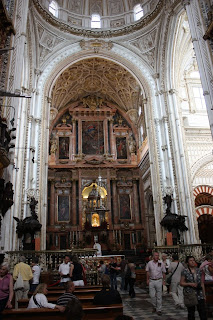The major event for the day was travel from Sevilla to Cordoba. We took the bus again for this trip. The bus was similar to the bus from Granada to Sevilla. The ride was shorter, just under 2 hours. The scenery was very similar. The areas outside of town are very rural. The topography reminds me of western South Dakota; it is very open with rolling hills. There are many fields where there appear to be olive trees growing and some with what appears to be small grains. There were also other types of orchards, but it was hard to tell the variety from the bus. We saw only a few fields with livestock: sheep and horses. I am surprised we saw no cattle.
We arrived in Cordoba late-afternoon. We decided to walk the mile (or so) to our hotel from the bus station. Our hotel is on the major road in town. The road is actually a boulevard that contains a very park-like median. There are plenty of trees, fountains, and benches to make it a pleasant walk. That is unless you are too busy looking up and not at the uneven sidewalk, tripping and tumbling to the ground. Luckily Amy was OK and we were close to the hotel.
Our hotel is very nice. Rather then the Spanish charm we have had in Granada and Sevilla, this hotel has a very modern feel. The exterior of the hotel is clad in an oxidized iron skin with 2-8 inch holes in a regular pattern. There is also a very fine pattern of 1/8 holes. I suppose this provides a nice sunscreen to help keep the hotel cool. The inside is dark, mainly black and charcoal gray with blue LED accent lights. There is also a pool on the roof. Unfortunately, we have a limited view of the surrounding area because of the screening. Our room is very nice. Amy was excited to see we have a jacuzzi tub after her mishap on the sidewalk. Our window looks our onto the boulevard park we walked through from the bus station. Unfortunately, there is only free internet in the lobby.
We had not planned on going to the Mezquita today, but we decided that we should try because tomorrow is Palm Sunday. As in Sevilla, there are many preparations for the upcoming holy week celebrations. Escher visited Cordoba and Granada in both 1922 and 1936. In 1936 he did a nice charcoal drawing. We saw an original at the Gemeentemuseum last week. He and his wife Jetta also copied some of the patterns decorating parts of the Mezquita.
After a short walk from our hotel via twisting and narrow streets, we arrived at the Mezquita, the Spanish word for mosque. Technically it is cathedral and not a mosque, as the vistor's guide emphasized. "Thus the beauty of the Cathedral of Cordoba does not reside in its architectural grandeur, but in the apostolic succession of the Bishop as a symbol of his pastoral service and the unity of the Church, founded upon the Word of the Lord, the sacraments, and the community of the believers." states the brochure. That may be so, but we are here to see the architecture.
 The high altar of the Christian cathedral located in the middle of the former mosque. Interestingly, the former mihrab of the mosque is still elaborately decorated with Islamic script.
The high altar of the Christian cathedral located in the middle of the former mosque. Interestingly, the former mihrab of the mosque is still elaborately decorated with Islamic script.The Mezquita is very interesting. The interior was immense, supported with hundreds of columns reused from other sites in the area. The columns are short, but a double arch structure was used to gain height. The arches have an alternating red brick and white stone form. This gives the arches a unique striped pattern. Escher used arches decorated with this striping in works such as High and Low.

This site is very old. An ancient christian temple, San Vicente, from the Visigoth era lies under the Mezquita. "It is a historical fact that the basilica of San Vicente was expropriated and destroyed in order to build what would later be the Mezquita, a reality that questions the theme of tolerance that was supposedly cultivated in the Cordoba of the moment." However, I read several other neutral sources that indicated Christian, Muslim, and Jewish people coexisted under Islamic rule. Certainly there are documented incidents where Christians and Muslims destroyed the former temples and erected new temples in their place. One of the interesting aspects of this part of Spain is that there are still places to see of Islamic origin and influence that were created during the Islamic dynasty in Spain 1000 years ago.
On the way back from the Mezquita, Amy and I decided to have a bite to eat. We had a drink and some tapas near our hotel. They do not start serving dinner until 8:30. Spain seems like it runs like many college students at home. Get up late, do some things, take a nap or relax, then party or work late into the evening. You can easily find a place to eat a full meal here at midnight. It will still be packed and very lively. I suspect one can visit Spain from the USA and generally not worry about the 6 hour time change, especially if you are an early riser at home. We then had a more substantial meal at the hotel and we are just watching soccer on TV.



I can't believe mom fell!!! I hope you're alright, Mom!
ReplyDelete